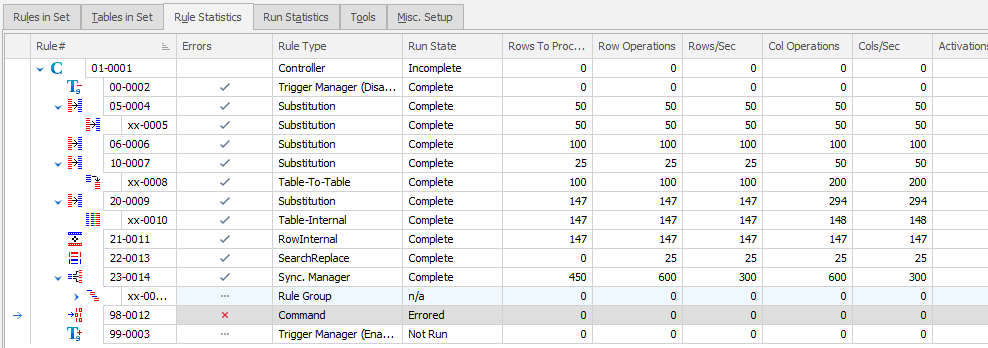The Rule Statistics Tab
Published 06 January 2020
The Data Masker Rule Statistics Tab
The primary function of the Rule Statistics tab is to provide a record of the status of individual masking rules as the masking set is executed. The current execution state and statistics are presented for each rule individually. Aggregate statistics for the masking set as a whole and specific statistics for those masking rules currently executing can be found on the Run Statistics tab.
The masking rule display at the top of the Rule Statistics tab lists all rules in the current masking set. There are eleven vertical columns in the masking rule display. These columns provide specific information on various components of the rule. All of the statistics fields are "live" and will constantly update as the rule is executing. All columns can be sorted by clicking in the column header above each type of statistic.
What the columns in the Rules Panel mean
Rule#
This column indicates the block and ID number of the rule and also contains a small icon which indicates the masking rule type. For example:
Rule Controller
Substitution rule
Shuffle rule
Insertion rule
For whole details, about rules and description look here.
The rule block and ID number are displayed as a sequence of digits in the form XX-YYYY. The XX value is the rule block and the YYYY component is the rule ID. The ID of the rule is not particularly significant and serves only to provide a unique identification number for the rule. The rule block, however, is of considerable significance since it controls the execution order of the rule. The Data Masker software is multi-threaded and can run up to eight rules in parallel. It is common to have a situation in which certain rules cannot run simultaneously and must run sequentially one after the other as a chain. The rule block value (along with dependency relationships) control the execution sequence. Please see the Rule Blocks and Dependencies help page to understand how to explicitly control the execution order of the masking rules.
Errors
Each line describing a rule has a button in the Errors column. If an error occurred during execution, this button will change to a red X indicating that the rule had errors. Pressing on the button will launch a diagnostic form which displays diagnostic and debugging information regarding the error.
Rule Type
This column names the type of rule and will be an abbreviated form of the full rule type in order to minimize display space.
Run State
This column indicates the execution state of the rule.
Rows to Process
This column indicates the number of rows processed by the rule. If a rule is currently executing, this display will be updated periodically. When the masking rule has completed, this figure will indicate the total number of rows processed and it will be equal to the value in the Rows to Process column. Some rules, such as Command rules cannot return information regarding their progress. In these cases, this field will be blank.
Row Operations
This column indicates the number of rows processed by the rule. If a rule is currently executing, this display will be updated periodically. When the masking rule has completed, this figure will indicate the total number of rows processed and it will be equal to the value in the Rows to Process column. Some rules, such as Command rules cannot return information regarding their progress. In these cases, this field will be blank.
Row/Sec
Masking rules will execute at a variety of rates depending on the rule type, database configuration and a large number of other factors. This field provides an indication of how many rows each rule is processing per second. The value is derived from the other statistics via the formula: (Rows Processed)/(Time in Seconds). If the Time in Seconds field is less than 1 then a value of 1 second is assumed. Since fractional seconds are not tracked, this can make the calculated rows per second value seem much lower than it really is for small amounts of data. Note that the time taken to acquire the Rows to Process value is included in the calculation.
Col Operations
The number of column operations processed by the rule.
Col/Sec
Some types of masking rule (such as Substitution rules) have the ability to operate on multiple columns within the same rule. This provides a dramatic speed improvement. The Cols/Sec information is the Rows/Sec value multiplied by the number of columns the rule is masking.|
Activations
The number of times when a rule has been activated.
Run Time
This is the total run time printed in a human-readable format. This field will update continuously while a rule is executing.
Statistics Report Received
During execution, DataMasker is checking statistics table for rules and run. And this is a number of a total number of statistics report received from all remote databases.









